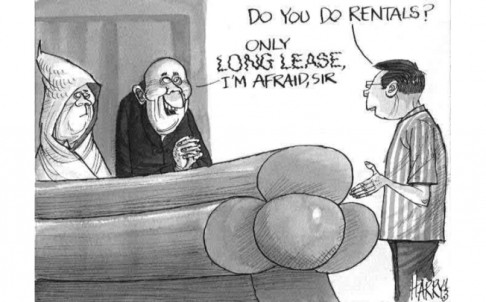
Dead have more space than tenants of subdivided Sham Shui Po flat
Sham Shui Po flat divided into 17 bed spaces highlights housing crisis for poor
Hong Kong's dead have more space to lie down than some of its living. The smallest room in one Sham Shui Po flat divided into 17 cubicles measures just 2 feet by 6 feet compared to the average coffin size of 2.3 feet by 7 feet - although, unlike a corpse, the tenant at least has space to sit up.
Social workers say the drive to create such bed spaces is intensifying in response to soaring rents and a government crackdown on illegally subdivided flats without any resettlement policy that is forcing tenants into the streets.
Mui Chok-kit pays HK$1,500 a month for the smallest room in the Sham Shui Po flat, which the 60-year-old took when he moved out of a government shelter for the homeless in Cheung Sha Wan six months ago. "I've lived on the streets before," he said, explaining why he was desperate for anything he could get with his welfare money. He sleeps sideways and partly curled up so he can fit into the tiny space.
The was told there were other subdivisions in Sham Shui Po similar to the 17-space flat.
An organiser with the Society for Community Organisation (Soco), Gordon Chick Kui-wai, said he had heard of flats being divided into 30 spaces.
Soco director Ho Hei-wah said the addresses could not be revealed as it would only mean trouble for the tenants. "With no government policy [on housing displaced tenants], they will just end up being kicked out."
Frankie Pong Chin-pang, 65, who has lived in a 20 sq ft room for four years, said: "This is hell. The worst is when it's hot. But my situation is not the worst. At least I'm healthy." Pong, who like Mui pays HK$1,500 a month, says he earns HK$1,000 to HK$2,000 a month from odd jobs and some days he can only afford a couple of pineapple buns to eat.
Most tenants in the Sham Shui Po flat were waiting for public housing. One tenant, Chan Chi-kwong, has been in the queue since 2004. Only one of the 17 spaces was empty and most tenants were steady. "Just sightly bigger rooms in the area could cost over HK$3,000 plus deposit," said Chan, who earns about HK$5,000 a month.
Bed spaces were separated by painted wooden boards, and with narrow corridors it was a dangerous firetrap, Chan said.
Two members of the Long-Term Housing Strategy Steering Committee, Marco Wu Moon-hoi and Wan Man-yee, visited tenants and were greeted by sweltering heat, doors so narrow they had to enter sideways and halls formed from boards. "Seeing that, my heart just cried out loud," Wan said.
They called for registration and licensing of subdivided spaces, and measures to ensure safety and hygiene. Wan criticised councillors who rejected plans to build public housing claiming it would block air flow and trap pollution. "Come and have a look at the ventilation in these subdivided flats," he said.

